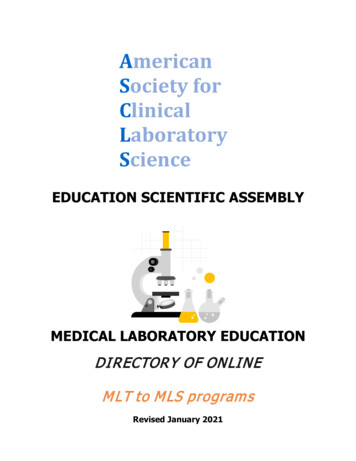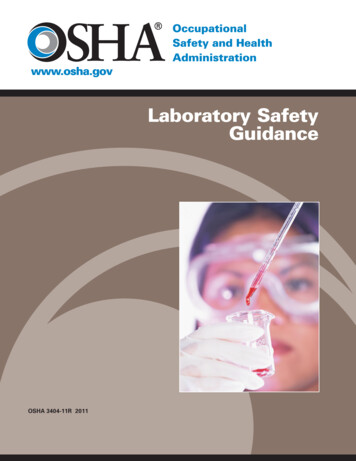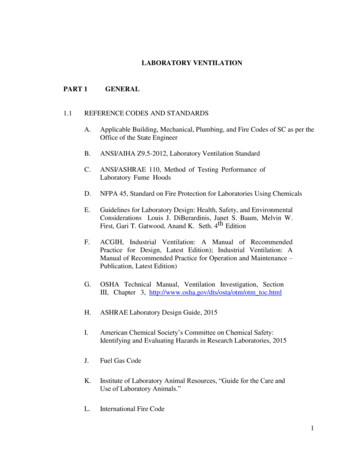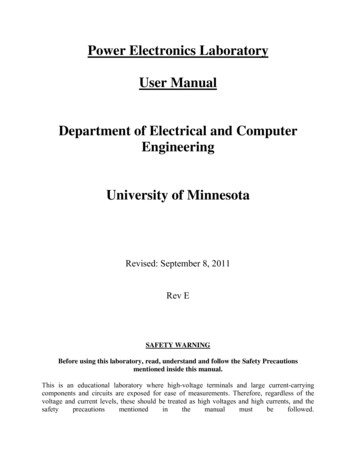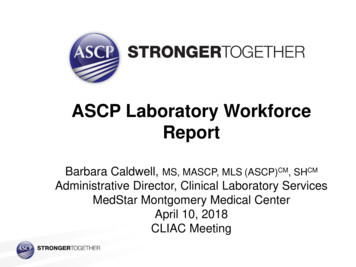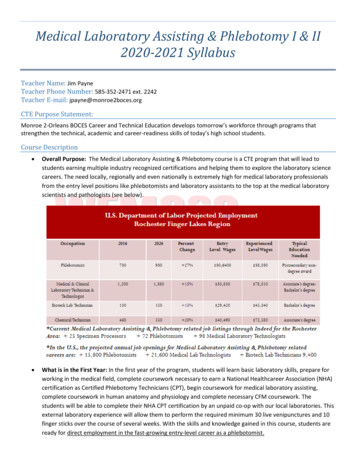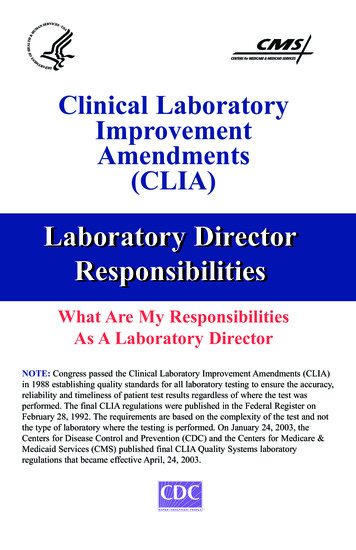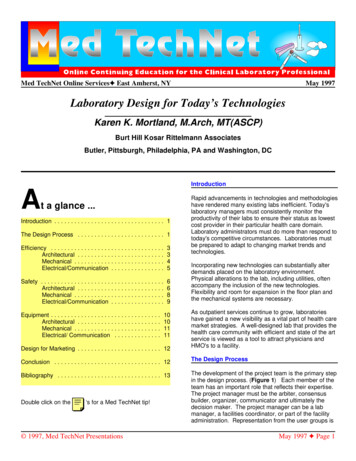
Transcription
Med TechNet Online ServicesEast Amherst, NYMay 1997Laboratory Design for Today’s TechnologiesKaren K. Mortland, M.Arch, MT(ASCP)Burt Hill Kosar Rittelmann AssociatesButler, Pittsburgh, Philadelphia, PA and Washington, DCIntroductionAt a glance .Introduction . . . . . . . . . . . . . . . . . . . . . . . . . . . . . . . . . 1The Design Process . . . . . . . . . . . . . . . . . . . . . . . . . . 1Efficiency . . . . . . . . . . . . . . . . . . . . . . . . . . . . . . . . . .Architectural . . . . . . . . . . . . . . . . . . . . . . . . . .Mechanical . . . . . . . . . . . . . . . . . . . . . . . . . . .Electrical/Communication . . . . . . . . . . . . . . . .3345Safety . . . . . . . . . . . . . . . . . . . . . . . . . . . . . . . . . . . . .Architectural . . . . . . . . . . . . . . . . . . . . . . . . . .Mechanical . . . . . . . . . . . . . . . . . . . . . . . . . . .Electrical/Communication . . . . . . . . . . . . . . . .6689Equipment . . . . . . . . . . . . . . . . . . . . . . . . . . . . . . . . .Architectural . . . . . . . . . . . . . . . . . . . . . . . . .Mechanical . . . . . . . . . . . . . . . . . . . . . . . . . .Electrical/ Communication . . . . . . . . . . . . . .10101111Design for Marketing . . . . . . . . . . . . . . . . . . . . . . . . . 12Rapid advancements in technologies and methodologieshave rendered many existing labs inefficient. Today'slaboratory managers must consistently monitor theproductivity of their labs to ensure their status as lowestcost provider in their particular health care domain.Laboratory administrators must do more than respond totoday's competitive circumstances. Laboratories mustbe prepared to adapt to changing market trends andtechnologies.Incorporating new technologies can substantially alterdemands placed on the laboratory environment.Physical alterations to the lab, including utilities, oftenaccompany the inclusion of the new technologies.Flexibility and room for expansion in the floor plan andthe mechanical systems are necessary.As outpatient services continue to grow, laboratorieshave gained a new visibility as a vital part of health caremarket strategies. A well-designed lab that provides thehealth care community with efficient and state of the artservice is viewed as a tool to attract physicians andHMO's to a facility.Conclusion . . . . . . . . . . . . . . . . . . . . . . . . . . . . . . . . 12The Design ProcessBibliography . . . . . . . . . . . . . . . . . . . . . . . . . . . . . . . 13The development of the project team is the primary stepin the design process. (Figure 1) Each member of theteam has an important role that reflects their expertise.The project manager must be the arbiter, consensusbuilder, organizer, communicator and ultimately thedecision maker. The project manager can be a labmanager, a facilities coordinator, or part of the facilityadministration. Representation from the user groups isDouble click on the‘s for a Med TechNet tip! 1997, Med TechNet PresentationsMay 1997Page 1
Laboratory DesignARCHITECTExpert on Lab DesignK MortlandPROJECT MANAGERENGINEERCommunicatorExpert on Lab SystemsConcensus BuilderExpeditorADMINISTRATION USER GROUPExpert on theExpert on theInstitution's Needs Laboratory's NeedsDesign development is the fleshing out of the schematicdesign (Figure 4). Casework elevations, equipmentFACILITIES REP.Expert on theBuilding's NeedsFigure 1 - The Project Teamnecessary to ensure that laboratory methodologies arefully understood by all team members. Theadministrative and facility members of the teamunderstand the long term goals of the overallorganization, and the limitations imposed by physical andfinancial constraints. The architects and engineers arethe experts in designing laboratories and the associatedsystems.A construction project is organized as five successivestages. Each stage incorporates a goal that must bereached before the project team may advance to the nextstage (Figure 2).Figure 3details, and engineering components are incorporatedinto the floor plan (Figure 5). Minor changes to theinitial design often result requiring review by the projectteam. It is normally difficult for people to get a feel forProject Design Phases Programming Schematic Design Design Development Construction Documents Bidding and Negotiation ConstructionFigure 2The Programming stage is where all issues that willaffect the lab and the facilities are presented andevaluated. The more information that is evaluated in thisphase, the better the new design will respond to the lab'sneeds. Areas such as equipment, personnel, existingconditions, and finances are used to develop goals forthe project. We have found that an intensive meeting,lasting as much as a week, can provide information,ideas and an understanding between all the variousmembers.Figure 4Schematic design translates these goals into a floor plan(Figure 3). Movement analysis of specimens, personneland patients need to be incorporated to ensure maximumefficiency in the general layout. A series of meeting toreview the plans are attended by the team members.Once satisfied that these preliminary designs fulfill thestatement of the problem, the project may advance to thenext phase.Figure 5 1997, Med TechNet PresentationsMay 1997Page 2
Laboratory Designthe actual space that the drawings are depicting. In themeetings ask the architect to relate sizes and spaces toareas that you know. Completion of designdevelopment completes the problem solving part of theconstruction project.The construction document stage shifts the constructionproject into a technical mode (Figure 6). The drawingsgenerated in the design development stage are detailedand materials are specified to prepare for construction.The architects and engineers are the only part of thedesign team that is involved in this stage. No majordesign changes should occur in this stage . The finaldrawings are considered contracts that must be adheredto by the contractor.K MortlandEfficiency (See Figure 7)Efficiency Functional Relationships Movement Flexibility Accessibility Energy ConsumptionFigure 7ArchitecturalFunctional relationships are the relationships betweenthe laboratory and the various areas of the facility thatcan affect patient, personnel and specimen movement.For example, functional relationships often existbetween the laboratory and emergency, phlebotomy,surgery, and intensive care units. Not only can theserelationships affect the efficiency of the lab and itspersonnel, they can also affect the nature of futureexpansion. An easy way to evaluate these relationshipsis through a bubble diagram (Figure 8). Using visualclues to organize and prioritize relationships the bestlocation and orientation of the lab can be determined.In the same diagram, areas that can support future labexpansion, whether interior or exterior, should beincluded.Figure 6The construction documents are then sent to a selectedlist of contractors for bidding. The contractor will reviewthe documents, contact subcontractors for prices, andtabulate a cost estimate for the project. A date is set forsubmission of these estimates and from these, theowners will select a construction company.The project finally reaches fruition in the last phase;construction. The architects and engineers will act asliaisons between the contractors and the owners. Theywill answer questions, review compliance with theconstruction documents and generate change orders ifnecessary.Figure 8Understanding the responsibilities of the variousmembers of a design team and the milestones that mustbe achieved during the design project allows everyone tobe organized and efficient. A lack of organization, in themultifaceted laboratory project, will result in lost detailsand cause immediate and future problems. 1997, Med TechNet PresentationsThe evaluation of movement addresses threeinterrelated concerns; patients, personnel, andspecimens. Patient use areas, including phlebotomy,donor areas, waiting and reception, and how they canbest relate to the lab should be discussed. This couldMay 1997Page 3
Laboratory Designinclude phlebotomy, donor areas, waiting and reception.This establishes the separation between the lab andthese areas as well as beginning an analysis of personnelmovement with the specimen that has been obtained.Following the normal paths that are traveled as personneldo their jobs can show redundancy of movement andinterferences. The third and most detailed of themovement analyses is specimen paths (Figure 9) thisFigure 9illustration of specimen movement provides visual cluesto aid in the more efficient organization of the lab. In arecent project, in which we were designing a Cytologylaboratory, we used the specimen movement diagram inthe meeting to help the users to relate how they need thespace to be set up. This same group used this method inreorganizing another lab that they had decided to add tothe project. They were prepared for the next meeting.K MortlandWith the rebirth of the core laboratory, an open centerfloor plan with casework situated around the periphery ofthe lab most easily adapts to the inclusion of newequipment and procedures. As the architectural designprogresses, a balance between the amount ofpermanently mounted casework versus movablecasework must be struck. Micro changes to individualworkstations, counter areas that house equipment, andstorage, can make the lab ready to accept procedures,equipment and personnel changes due toconsolidations, technological advancements and costcontainment. With today's necessary emphasis onfacility flexibility comes one cautionary note; in the questfor design excellence, technologists and administratorsmust be prepared to abandon the "way we've alwaysdone things" and open their minds to new ways oforganizing the lab. A Microbiology lab that was recentlyconstructed made the level of flexibility a major issue intheir design exploration. Several members believedthat there was no need for any flexibility and a fixedcasework plan, exactly like their previous lab, would beperfect. Other members, who had worked with flexiblecasework in other labs were strong advocates for theiruse. As the project progressed a decision was made tokeep the perimeters fixed, but allow the peninsulas,where the workstations were located, to be flexible. Thisallows the easy addition of equipment that they areconsidering purchasing.MechanicalThe proximity of existing air handlers, ductwork, risers,and plumbing should be evaluated to minimizeFigure 10Figure 11The laboratory must be designed to flexibly adapt tochanges in technologies and marketplace (Figure 10).disruption and costs (Figure 11). Optimal location ofmechanical components will lower material costs, allowmore ceiling space, and reduce energy consumption.When the ideal location for the lab is a considerabledistance from an existing air handler it may prove more 1997, Med TechNet PresentationsMay 1997Page 4
Laboratory Designefficient and less disruptive to add a new air handler tothe project. Many facilities handle this situation bylocating labs on upper floors to minimize the distancebetween the lab, the air supply and the exhaust area. It isimportant to locate areas that require many air changes,such as a BSL3 lab, close to risers. An example of theproblems that this can create was a new BSL3 lab thatwas located in an existing wing of a facility that had noextra capacity on the air handler that fed that area. Toadd to this problem there was a very low floor to floorheight, leaving little room for ductwork. The solutioninvolved running ductwork from another wing down theoutside of the building. This was very expensive, and nota pleasant addition to the exterior facade. The ductwork,coming into the lab, had to be brought through anexisting window, as there was little space above thewindow to contain it.In all projects, zones will be created depending on similarair and temperature demands and fire spread evaluations(Figure 12). These zones require separate ductruns andK Mortlandwas reached in a Pennsylvania hospital to easemaintenance headaches. They paint the pipes in colorsthat announced their purpose. The fire protection pipingwas red, gases - yellow, and water - white. This alsoeliminated an ongoing problem of labels falling off.Energy efficiency is important because of potential longterm cost savings. In a lab project, that has such heavydependency on air supply and exhaust, shorter duct runsare more efficient. Significant energy savings can beachieved by using well-insulated ducts that supplycooled or heated air and by updating windows andinsulation. Evaluating lab equipment, a task that canfall to lab personnel, architects and engineers, or specialequipment consultants, shows differences inconsumption and life cycle costs. Life cycle informationshould include maintenance history, warranties,obsolescence and utilization projections.Electrical/CommunicationThe locations and amounts of existing electrical andcommunication panels dictate wiring patterns. Often theaddition of new panels and electrical closets isnecessary due to increased amounts of specializedpower and data. These panels and closets should becentralized in the lab for easy access and shorter wiringruns.Accessibility applies to the wiring systems as it does toall engineering. Utilities may be organized and easilyaccessed when above ceiling cable trays are utilized.This feature occupies some ceiling space and must bedesigned in coordination with ductwork, lighting andplumbing. By designating specific above ceiling layersfor each set of mechanical components, interferencescan be reduced (Figure 13).Figure 12controls. The relationships between like spaces, such asall the Level 3 labs, should dictate the location of thesespaces in the overall plan. This will minimize the amountof ductwork, and reduce the size of the ducts required inspaces that have lower requirements.Flexibility in a mechanical sense refers to the ease ofchange and maintenance for plumbing, controls andductwork. If access requires removing plaster ceilings,demolishing walls or digging into concrete floors, thedisruption and costs that result will severely limitchanges. By utilizing open or suspended ceilings moreflexibility is achieved. Labeling the pipes and ductworkmakes maintenance easier: an innovative solution that 1997, Med TechNet PresentationsMay 1997Page 5
Laboratory DesignK Mortlandthe hood itself if there is a lot of movement in and out ofthe door. The currents caused by such movement caninterfere with the hood's air flow.All materials that are used in the construction of a labmust meet codes for fire spread. Properly constructedwalls and ceilings create a barrier to the spread of fire(Figure 14). Areas that house gases and largequantities (greater than 100 square feet) of dry storagemust be separated by walls that retard the passage offire and smoke for one or two hours. The location offire extinguishers beside doors in areas that houseflammables is a CAP requirement. It is prudent to havefire extinguishers next to the door in any lab that useschemicals that could cause a fire.Figure 13Egress and construction requirements vary according tothe amounts and types of chemicals stored in the lab.The National Fire Protection Association (NFPA) codesOutlets and lighting can be installed to allow flexibility.By using raceways that house both electrical and datawiring, outlets can be easily added, moved or eliminated.Task lighting should be switched individually and bemovable with the use of simple tools. Good overalllighting in the lab, in addition to task lighting, will supportmost procedural and equipment changes. A problem thatcan be encountered, in relation to lighting, is theorientation of workspaces to the lighting. If during someminor changes the workstations become oriented parallelto lighting, as opposed to perpendicular, there can beshadows. The exception to this rule is Histology. In ahistology lab there is special consideration necessary forthe waterbaths used in cutting areas. Histologists that wehave worked with have expressed preferences forlighting to be parallel.SafetyArchitecturalLaboratory safety is mandated through codes. Life safetycodes have been issued and expanded over time bygovernment, insurance companies and specializedregulatory agencies. Their basic premise is to protectpersonnel and patients. In laboratories, fire codes arefrequently overlooked as space becomes strained.Boxes, refrigerators, trash cans, and equipment are oftenplaced in exit corridors and in front of fire hose cabinets.Such space problems that actually interfere with thequality of work and the safety of personnel are College ofAmerican Pathologists (CAP) deficiencies. Havingsufficient storage and flexibility in the lab helps limitfuture violations.Figure 14give three classifications for labs depending upon theamounts of flammable and combustible chemicals thatare stored (Figure 15). It is generally acceptable in atypical clinical lab to have a sprinklered chemicalstorage space with a wall that can contain a fire for onehour. It is good practice to supply the project designteam with a quantitative list of flammable andhazardous materials used and stored in the lab.Emergency eye washes and showers are required wherecorrosive and toxic chemicals are used. These areHood locations can also cause egress code problems. Ifa hood is located next to an exit door, a second doormust be supplied. This situation can cause problems in 1997, Med TechNet PresentationsMay 1997Page 6
Laboratory DesignLaboratory Classifications Class A High Hazard 10 to 20 gal. of various flammable or combustibleliquids allowed Class B Intermediate Hazard 5 to 10 gal. of various flammable or combustibleliquids allowed Class C Low Hazard 2 to 4 gal. of various flammable or combustible liquidsK Mortland(ANSI) has specific performance requirements for bothunits (Figures 16 & 17). A common problem is themess associated with the regular testing of the eyewashunits. The fixed eyewashes with attached basins can beneatly tested if a cylinder is put over the unit beforeactivating. This will direct all the water into the basin.Biosafety levels are more important today with theexpanding usage of DNA Amplification. The Center forDisease Control and Prevention (CDC) and the NationalInstitutes of Health (NIH) have categorized therequirements of the four levels (Figure 18). Levels 1and 2 follow standard lab practices of safety. HandwashallowedFigure 15Biosafety Levels BSL 1 -Emergency Eyewash water remains on without use of hands (hands to hold eyes open)goes from off to on in one second or lesslarge and easy to operate controlsdelivers 0.4 gal of water per minutewater nozzles 33 to 45 inches above floorvisible signchecked and flushed weekly BSL 2 - BSL 3 - BSL 4 -Figure 16Infectious agents not known to causedisease in healthy adultsInfectious agents associated withhuman disease. Ability to infectthrough autoinoculation, ingestion, andmucous membrane exposureInfectious agents with potential foraerosol transmission. Effects may beserious or lethalInfectious agents which pose high riskof life-threatenting disease, aerosoltransmitted lab infections, or agentswith unknown risk of transmissionFigure 18Emergency Shower opens in one second water remains on without use of handsdelivers 30 gal of water per minuteeasy to locate and accessible controlshead at 84" from flooradjustable water supplyvisible signchecked and flushed weeklyFigure 17chosen and located by the architect and the mechanical(plumbing) engineer. An eyewash must be a fixed unitthat allows the users hands to hold both eyes open duringoperation, thus eliminating the use of squeeze bottles inlabs. The basic requirement for both units is that it takesonly ten seconds to reach the unit from the hazardousarea. The distance that can be traveled in this timeframe has been calculated to be 100 feet. However thisshould be evaluated on an individual basis to best protecttechnologists. The American National Standards Institute 1997, Med TechNet Presentationssinks, and cleanable surfaces are common to both. Anemergency eyewash is required in Level 2 labs. Level 3and 4 have progressively stricter requirements relatingto emergency equipment, windows, cleanablity ofsurfaces, furniture and utilities minimizing contaminationof people and facilities (Figures 19, 20 & 21).ADA and ergonomic guidelines are easilyaccommodated in the lab design if considered early.Allowing adequate room for wheelchairs, someadjustable casework, and observing height requirementsfor light switches, outlets, and safety equipment willallow you to meet most requirements of a handicappedemployee (Figure 22). Often overlooked in lab designis allowance next to doors for maneuvering space. It isrecommended that 2'-0" clearance exists on the latchside of a door. Door sizes that are allowable for ADAMay 1997Page 7
Laboratory DesignFacility Requirements for BiosafetyLevel 3 Separate from traffic areas through two sets of selfclosing doors Hand-free handwash sink near door Interior surfaces water resistant and sealed Bench tops impervious to water, resistant to acids,alkalis, solvents and moderate heat Spaces between furniture and benches accessiblefor cleaning Windows closed and sealed Decontamination method available Directional ducted exhaust air provided HEPA filters in biosafety cabinets Eyewash facilityFigure 19are often less than is necessary for movement ofequipment. It is best if all the lab doors are four feetwide. Companies are developing equipment, such asbiosafety cabinets, that is accessible to personnel withdisabilities.K Mortlandexample, long periods of exposure to low levels ofnoise, called white noise, can cause fatigue, irritationand headaches. Laboratorians must stand to dophlebotomy or work on equipment. Antifatigue mats canease back strain. A common ergonomic problem in labsis slippery footing. Areas with slip hazards, such ashistology, should employ gripping surfaces instead oftraditional flooring. Water spills can be controlled withmats at sink areas. Such mats are also beneficial inprotecting flooring from spilled stains.Facility Requirements for BiosafetyLevel 4 Same as BSL 3 - plus . Located in separate building or zoneFloor drain; all surfaces able to be fumigatedConstructed to minimize dust settling areasDoors lockableDouble-door autoclave for exiting materialsDecontamination method for non-autoclavablematerialsHeat treatment for liquid wastes to sewersMonitored differential pressure and directionalairflowHEPA filtered exhaustPossible suit area with decontamination showerFigure 21ADA Guidelines Minimum door size - 32" Figure 20Ergonomics, designing to help prevent work-relatedmusculoskelatal disorders, is addressed in several ways.Well designed and adjustable chairs, keyboard trays, andmonitor arms allow personnel to keep from being frozenin a fixed position every day, and subsequentlydeveloping problems. Noise and vibrations, irritantsknown to cause mental and physical problems foremployees, must be addressed, especially in situationswhere large amounts of equipment are used. For 1997, Med TechNet PresentationsClear width for wheelchair - 36"Wheelchair turnaround space - 60" diameterForward reach - 15" to 48" above floorReach over counter - 44" maximumKneespace - 30" wideLavatory height - 29" to 34" above floorCountertop height - 34" maximumApron height - 34" maximumFigure 22MechanicalThe passage of fire through ductwork, and openings inwalls for pipes and ducts are addressed by NFPA. Thecode states that the passage of smoke, fire or vaporsshall be prevented between fire rated floor or walls.This requirement, in practice, dictates the use of firedampers. The best addition to any laboratory, toMay 1997Page 8
Laboratory Designprevent fire spread and to protect personnel, is anautomatic sprinkler system.Protecting technologists and the patients they areassociated with requires the addition of separatehandwash sinks, either countertop or lavatory. The U.S.Department of Health and Human Services (DOH)regulations allow countertop sinks, designated forhandwashing, to be used to dispose of nonhazardouswaste. It is good practice, however, to designate a sinkwith foot pedal controls near the exit, for the sole purposeof handwashing.K MortlandMechanical requirements associated with the Biosafetylevel 3 are noted in Figure 19. Levels 3 and 4 requiredirectional air flow, meaning that air must move awayfrom the doors towards the back of the room (Figure24). This ensures that any contamination that may getVentilation of vapors becomes more important as it islearned that many chemicals regularly used in labs areconsidered carcinogenic. In areas, such as histology,that use known carcinogens with regularity, a downdraftmethod of ventilation should be employed (Figure 23).This keeps the fumes of the xylene and formalin, knownFigure 24Figure 23to be heavier than air, away from the technologist's face.It is required by the Occupational Safety and Health Act(OSHA), that work with carcinogens be performed in aproperly functioning laboratory type hood , closed systemor device that provides equivalent protection. Insidefume hoods the same downdraft design should beemployed. Purchase a fume hood that pulls vaporsdirectly back away from the users face.Ventilation and exhaust from flammable storage cabinetsis not required. The purpose of these cabinets is toseparate chemicals from a fire. Venting these cabinetshas not been proven beneficial. Venting flammablestorage into a fume hood creates the potential of aflashback into the storage cabinet. If there is concernabout combustion inside a cabinet it is prudent to install asprinkler head inside. 1997, Med TechNet Presentationsinto the air will not pass into the ante room when thedoors are opened. Another requirement for level 4 isdifferential pressurization. When a room is negativelypressurized, typical for most labs, isolation rooms andbathrooms, air moves into the room. This keepscontamination and noxious fumes from moving out intoadjacent spaces. Positive pressurization, often used inclean rooms and reverse isolation, means that the airwill move out of the room. In labs the majority of thespaces will be negatively pressurized in comparison withthe corridors and offices. There is the occasion topositively pressurize lab areas that are sensitive tocontamination from outside the space, but there must benothing that is potentially harmful to people outside thespace.Electrical/CommunicationMost of the codes regulating wiring, in relationship to fireprevention in labs, are universal. Fire alarms,connected to the sprinkler system, must be equippedwith audible and visual signals. Equipment cords, oftenfound in spaghetti like tangles on countertops and floors,should be controlled with wire management. Wires andcables interfering with traffic is considered a CAPdeficiency. Controlling the cords necessitates the use ofundercounter chases or hooks that keep excess wire offthe floor. Including extra outlets for both data andelectric eliminates long runs of cords, and so eliminatesthe potential hazard of extension cords and outletadapters.May 1997Page 9
Laboratory DesignK MortlandFigure 25EquipmentArchitecturalNew equipment technologies often create the need toredesign. In particular, robotics has had a profoundeffect on the layout of labs. In the past, automation hasbeen departmentalized. In a robotic equipped lab, thechemistry, hematology, immunology and toxicologyanalyzers are together in one area, often directly linkedwith specimen preparation areas. Separating theequipment would be contradictory to the efficiency andcost of the robotics. The space allowed for robotics isdependent on the extent of the system and on thepersonnel changes that will be associated with the newprocedures. Most often the lab will be designed with theanticipation of a robotics purchase. A core lab isdeveloped with specimen preparation immediatelyadjacent. A space that allows for a linear orientation ofthe equipment is the most cost efficient. It is alsoimportant to allow space for the robotic system to 1997, Med TechNet Presentationsexpand. Areas, such as immunohematology andmicrobiology, still relying on extensive manualtechniques and individual pieces of equipment, willbecome more and more automated and capable ofconnections to a robotics system.Robotics and other individual pieces of equipment canstress existing structural systems. It is important tocheck statistics on each item related to weight andsensitivity to vibration. Of special concern are itemswith large point loads, a large weight set on a smallarea. An irradiator, for example, may necessitateaugmentation of the existing supports in the floor, orplacement in a space that can support the load. Pointloads have also become important with liquid gascontainers and sliding storage systems.Acoustics is a problem in any area that houses largeamounts of automation. In the large space required forrobotics, a source of white noise, acoustics must becreatively handled. Open ceilings, tile floors and bareMay 1997Page 10
Laboratory DesignK Mortlandwalls, often used in labs will reflect the noise and worsenthe problem. Core labs must have acoustic panels in theceiling. Different levels of sound absorption are availablefrom various manufacturers. It is best to specify themost absorbent. One particular project, a renovationproject that opened up into a core lab ready for robotics,experienced immediate acoustic problems. The solutionwas partial height movable panels placed behind theequipment. These are not only sound absorbent but canhide and control wires and plumbing lines running to thefloor. Their movability allows easy access to the backsfor maintenance. For large noise problems, wall panelsand ceiling hung acoustic panels can be used.With robotics come
between the lab, the air supply and the exhaust area. It is was red, gases - yellow, and water - white. This also important to locate areas that require many air changes, eliminated an ongoing problem of labels falling off. such as a BSL3 lab, close to risers. An example of the problems that





